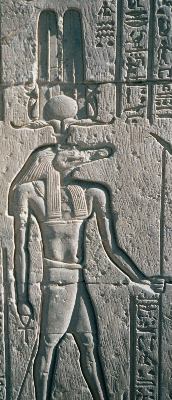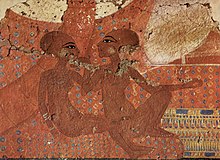Art of ancient Egypt
| Ancient art history |
|---|
| Middle East |
| Asia |
| European prehistory |
| Classical art |
Ancient Egyptian art refers to the style of painting, sculpture, crafts and architecture developed by the civilization in the lower Nile Valley from 5000 BC to 300 AD. Ancient Egyptian art was expressed in paintings and sculptures & was both highly stylized and symbolic. Much of the surviving art comes from tombs and monuments and thus there is an emphasis on life after death and the preservation of knowledge of the past.
In a more narrow sense, Ancient Egyptian art refers to the canonical 2nd and 3rd Dynasty art developed in Egypt from 3000 BC and used until the 3rd century. Most elements of Egyptian art remained remarkably stable over that 3000 year period without strong outside influence. The same basic conventions and quality of observation started at a high level and remained near that level over the period.
Periods

- Predynastic (4210 BC–2680 BC)
- Old Kingdom (2680 BC–2258 BC)
- Middle Kingdom (2258 BC–1786 BC)
- New Kingdom (1786 BC–1085 BC)
- Amarna Period (1085 BC–1055 BC)
- Late Period (1055 BC–287 BC)
- Ptolemaic
Symbolism
Symbolism also played an important role in establishing a sense of order. Symbolism, ranging from the pharaoh's regalia (symbolizing his power to maintain order) to the individual symbols of Egyptian gods and goddesses, is omnipresent in Egyptian art. Animals were usually also highly symbolic figures in Egyptian art. Colors were more expressive rather than natural: red skin implied vigorous tanned youth, whereas yellow skin was used for women or middle-aged men who worked indoors; blue or gold indicated divinity because of its unnatural appearance and association with precious materials; the use of black for royal figures expressed the fertility of the Nile from which Egypt was born. Stereotypes were employed to indicate the geographical origins of foreigners[1]
Art forms

Ancient Egyptian art forms are characterized by regularity and detailed depiction of human beings and nature, and were intended to provide company to the deceased in the other world. Artists endeavored to preserve everything of the present time as clearly and permanently as possible. Completion took precedence over style. Some art forms present an extraordinarily vivid representation of their time and the life, as the ancient Egyptian life was lived thousand of years before.
Egyptian art in all forms obeyed one law: the mode of representing man, nature and the environment remained almost the same for thousands of years and the most admired artists were those who replicated most admired styles of the past.
Architecture
Ancient Egyptian architects used sun-dried and kiln-baked bricks, fine sandstone, limestone and granite. Architects carefully planned all their work. The stones had to fit precisely together. Ramps were used to allow workmen to move up as the height of the construction grew. When the top of the structure was completed, the artists decorated from the top down, removing ramp sand as they went down. Exterior walls contained only a few small openings. Hieroglyphic and pictorial carvings in brilliant covers were abundantly used to decorate the structures, including many motifs, like the scarab, sacred beetle, the solar disk, and the vulture
Paper

The word paper is derived from "papyrus", a plant which was cultivated in the Nile delta. Papyrus sheets were derived after processing the papyrus plant. Some rolls of papyrus discovered are lengthy, up to 10 meters. The technique for crafting papyrus was lost over time, but was rediscovered by an Egyptologist in the 1940s. Papyrus was used by ancient Egyptians for writing and painting.
Papyrus texts illustrate all dimensions of ancient Egyptian life and include literary, religious, historical and administrative documents. The pictorial script used in these texts ultimately provided the model for two most common alphabets in the world, the Roman and the Arabic.
Pottery


Ancient Egyptians used steatite (some varieties were called soapstone) and carved small pieces of vases, amulets, images of deities, of animals and several other objects. Ancient Egyptian artists also discovered the art of covering pottery with enamel. Covering by enamel was also applied to some stone works.
Different types of pottery items were deposited in tombs of the dead. Some such pottery items represented interior parts of the body, like the heart and the lungs, the liver and smaller intestines, which were removed before embalming. A large number of smaller objects in enamel pottery were also deposited with the dead. It was customary to craft on the walls of the tombs cones of pottery, about six to ten inches tall, on which were engraved or impressed legends relating to the dead occupants of the tombs. These cones usually contained the names of the deceased, their titles, offices which they held, and some expressions appropriate to funeral purposes.
Sculpture

The ancient art of Egyptian sculpture evolved to represent the ancient Egyptian gods, Pharaohs, and the kings and queens, in physical form. Whether there was real portraiture in Ancient Egypt or not is still debated till now. Massive statues were built to represent gods and famous kings and queens. These statues were supposed to give eternal life to the kings and queens, and to enable the subjects to see them in physical forms.
Very strict conventions were followed while crafting statues: male statues were darker than the female ones; in seated statues, hands were required to be placed on knees and specific rules governed appearance of every Egyptian god. For example, the sky god (Horus) was essentially to be represented with a falcon’s head, the god of funeral rites (Anubis) was to be always shown with a jackal’s head. Artistic works were ranked according to exact compliance with all the conventions, and the conventions were followed so strictly that over three thousand years, very little changed in the appearance of statues. These conventions were intended to convey a timelessness and non aging representation of the figure's ka, or life for an eternal afterlife. And once the Egyptians entered the afterlife, thus began a long afterlife.
Hieroglyphs
Hieroglyphics are the ancient Egyptian writing system in which pictures and symbols stand for sounds and words. Jean-Francois Champollion first decoded hieroglyphics from Rosetta Stone, which was found in 1799. Hieroglyphics have more than 700 symbols.
Literature
Ancient Egyptian literature, most often written on papyrus, also contains elements of ancient Egyptian art, as the texts and connected pictures were recorded on papyrus or on wall paintings and so on. They date from the Old Kingdom to the Greco-Roman period.
The subject matter of such literature-related art forms include hymns to the gods, mythological and magical texts, mortuary texts. Other subject matters were biographical and historical texts, scientific premises, including mathematical and medical texts, wisdom texts dealing with instructive literature, fables and stories.
Paintings

Many ancient Egyptian paintings have survived due to Egypt's extremely dry climate. The paintings were often made with the intent of making a pleasant afterlife for the deceased. The themes included journey through the afterworld or protective deities introducing the deceased to the gods of the underworld (such as Osiris). Some tomb paintings show activities that the deceased were involved in when they were alive and wished to carry on doing for eternity.
In the New Kingdom and later, the Book of the Dead was buried with the entombed person. It was considered important for an introduction to the afterlife.
Egyptian paintings are painted in such a way to show a profile view and a side view of the animal or person. For example, the painting to the right shows the head from a profile view and the body from a frontal view. Their main colors were red, blue, black, gold, and green.
Evolution

The Ancient Egyptian art style known as Amarna art was a style of art that was adopted in the Amarna Period (i.e. during and just after the reign of Akhenaten in the late Eighteenth Dynasty), and is noticeably different from more conventional Egyptian art styles.
It is characterized by a sense of movement and activity in images, with figures having raised heads, many figures overlapping and many scenes busy and crowded. Also, the human body is portrayed differently in Amarna style artwork than Egyptian art on the whole. For instance, many depictions of Akhenaten's body give him distinctly feminine qualities, such as large hips, prominent breasts, and a larger stomach and thighs. This is a divergence from the earlier Egyptian art which shows men with perfectly chiseled bodies. Faces are still shown exclusively in profile. Not many buildings from this period have survived the ravages of later kings, partially as they were constructed out of standard size blocks, known as Talatat, which were very easy to remove and reuse. Temples in Amarna, following the trend, did not follow traditional Egyptian customs and were open, without ceilings, and had no closing doors.
In the generation after Akhenaten's death, artists reverted to their old styles. There were still traces of this period's style in later art. this painting aint shit.
See also
References
- ^ Historical Atlas of Ancient Egypt, Bill Manley (1996) pg83
External links
- Ancient Egyptian Art - Aldokkan
- The Art of ancient Egypt
- Senusret Collection: A well-annotated introduction to the arts of Egypt
- Ancient Egyptian Art at the Cincinnati Art Museum
- Ancient Egyptian art discovered in Qurta

